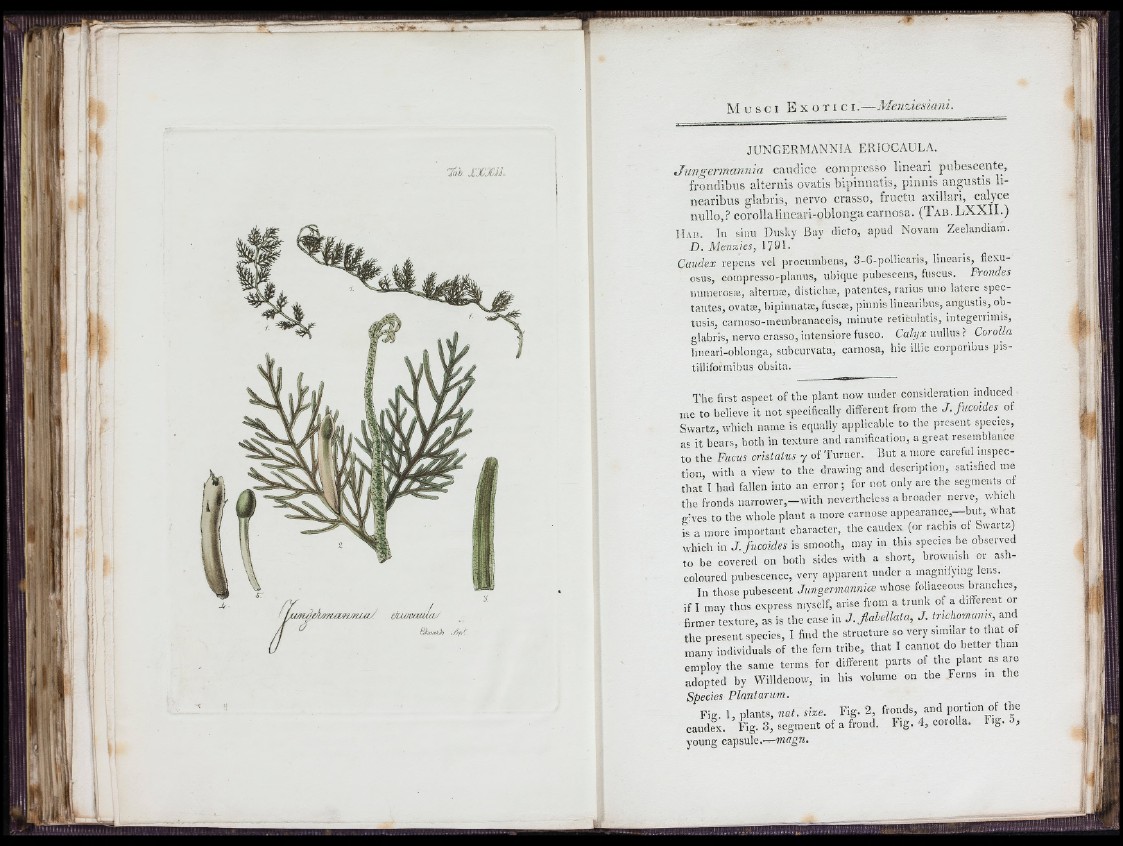
MTV.
%'h. XXJC'JL
,y/ r
JUNGERMANNIA ERIOCAULA.
J v n g c r v ia n n ia caiuiice com p re sse lin e a ri p u b e sc en te ,
fro n d ib u s a lte rn is ovatis b lp im ia tis , p in n is an g u stis lin
e a rib u s g lab ris, iiervo crasso, fru c tu axillari, calyce
nullo,.? co ro lla liiie a ri-o b lo n g a c arnosa. ( T a b . L X X I I .)
Uav. In sinu Dusky Bay dicto, apud Novam Zeelandiam.
D . Menzies, 179L
Caudex repens vel procumbens, 3-6-pollicaris, linearis, fiexu-
osus, compresso-plaims, ubique pubescens, fuscus. Frondes
numerosK, aiteniæ, distichæ, ¡ratentes, rarius uno latere^ spécialités,
ovatæ, bipinnatæ, fuscæ, pinnis linearibus, angustis, obtusis,
carnoso-membrauaceis, minute reticulatis, integerrimis,
glabris, nervo crasso, intensiore fusco. Calyx iiullus ? Corolla
lineari-obloiiga, subciirvata, carnosa, hic illic corporibus pis-
tilliforinibus obsita.
The first aspect of the plant now under consideration induced
me to believe it not specifically different from the J . fucoides of
Swartz, which name is equally applicable to the present species,
rfl it bears, both in texture and ramification, a great resemblance
to the Fucus cristaius y of Turner. But a more careful inspection,
with a view to the drawing and description, satisfied me
that I had fallen into an error ; for not only are the segments of
the fronds narrower,-wilh nevertheless a broader nerve, which
Rves to the whole plant a more carnose appearance, bid, what
is a more important character, the caudex (or rachis of Swartz)
which in J . fucoides is smooth, may in this species be observed
to be covered on both sides with a short, browinsli or ash-
coloured pubescence, very apparent under a inaginfymg lens.
In tho,se pubescent J u n g e r m a n n i oe whose foliaceous branches,
if I may thus express myself, arise from a trunk of a different or
firmer t'exture, as is the case in J . f l a h e l l a l a , J . t r k h o n r a n i s and
the present species, I find the structure so very similar to that of
manv individuals of the fern tribe, that 1 cannot do better than
empiovthe same terms for different parts of the plant as are
adopted by Willdenow, in bis volume on the Ferns in the
S p e c i e s P l a n t a r u m .
Fig. 1, plants, nat. size. Fig. 2, fronds, and portion of the
caudex. Fig. 3, segment of a frond, t ig . 4, corolla. Fig. a ,
young capsule.—-mng«.